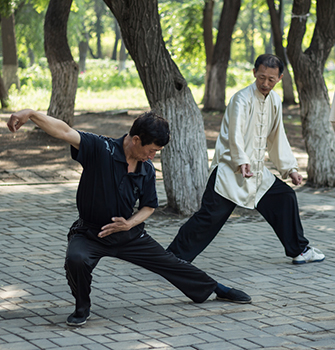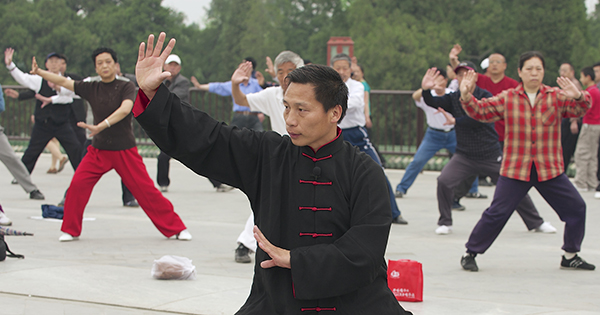There are several physiological responses that typically affect our peripheral vision. For example, the fight-or-flight response floods adrenaline into the bloodstream and results in pupil dilation. While this allows more light into the eyes and should enhance our peripheral vision, we train to avoid triggering this autonomic nervous system response due to other affects, like muscle tension and stress, increased heart rate and respiration, etc.
In the other direction, we have a tendency to shrink our environment down to a manageable size when it is too complex for us to take in everything. When overwhelmed with information, we tend to focus on a few details and ignore much of the available information that may otherwise lead to confusion. This is one reason why we perform better when we are calm. When we are calm, we can maintain a soft focus and an awareness of more of our environment.
Here are several exercises that can be used to test/train your peripheral vision:
1) Hold your arms straight out to your sides, or slightly behind your torso (you can, instead, bend your elbows so that the hands are at the sides of your head). Without turning your head, see if you can simultaneously detect both hands when you wiggle your fingers. Note: you should wiggle your fingers because our peripheral vision is weak in distinguishing detail, color, and shape, but responds well to motion.
2) Bounce a ball (a tennis ball or something similar) against a wall, and catch it while alternating the hand throwing and catching the ball. While doing this, look at a spot on the wall slightly above eye level and use your peripheral vision to keep track of the ball without looking directly at it.
3) A similar exercise can be done to test/train your vertical peripheral vision rather than your horizontal peripheral vision. While standing 4-5’ from the wall and looking at a spot on the wall slightly above eye level, toss the ball back and forth over your head from one hand to the other. Again, do not turn your head. When you toss the ball high enough to leave your field of vision, your peripheral vision will gain training as it attempts to track the ball as it comes back into your field of vision. This can be trained by practicing juggling.
4) One can use the “ruler drop test” which is used to test reflexes (instruction and videos are readily available on the web). First, test someone as they would normally do it, i.e. by focusing their eyes intently on the ruler, and catching it as soon as they detect its movement when the tester drops it. Then redo the experiment while looking at the ruler using ones peripheral vision instead. Most subjects will see an improved reaction time in the second version.
 It is not unusual for Taijiquan practitioners to be able to catch a falling object without much thought, and without having to look directly at the falling object. I suspect that this is due to enhanced peripheral awareness.
It is not unusual for Taijiquan practitioners to be able to catch a falling object without much thought, and without having to look directly at the falling object. I suspect that this is due to enhanced peripheral awareness.
Peripheral vision is better for being aware of our general environment than central/foveal vision is, and is composed primarily of rods, whose main function is to detect motion (note: there are still a sizeable number of cones, although much less densely distributed than in the fovea). The spatial resolution of the peripheral visual field is relatively coarse. Central/foveal vision, composed primarily of cones and making up only about 1.7 degrees of the visual field, is better at occupying our attention on specific details.
While many sports and martial arts mention peripheral vision, Taijiquan’s from-contact emphasis in interactions may allow peripheral visual awareness to play a greater role than in non-contact situations. Our brains cannot focus specifically on more than one or two things at a time, and if we focus too intently on one thing, we can miss the numerous other things happening around us. If we do not need to focus our eyes directly on something, then our reaction times can improve.
Our reaction time for tactile stimuli is significantly faster than for visual stimuli, and our peripheral awareness reaction time is faster than our central/foveal vision awareness time. Both of these enhancements are in effect when doing from-contact interactive Taijiquan with soft-focus eyes. This from-contact emphasis is one thing that differentiates Taijiquan from most striking arts.
While peripheral vision does not create a lasting impression, and could be considered as being nearly subconscious, it does provide reliable information that allows quick and accurate maneuvering through space. Ambient visual awareness, provided by peripheral vision, is enhanced in nocturnal primates, when compared to diurnal primates like humans. This is due to their visual needs in dimly lit environments.
Although there are not studies of peripheral awareness in Taijiquan that I am aware of, there is increasing interest in peripheral awareness and Alzheimer’s disease since it is one of the first things to deteriorate in that condition, accompanied by poor movement and frequent falls. Studies seem to indicate that improving peripheral awareness not only helps balance and movement, but also may improve anxiety levels and relaxation, mood, and comfort breathing, among other things. It may show some of these effects in fit individuals as well, although research would need to be done to test this.
For those with further interest in peripheral awareness, a good recent (2016) summary article by Ruth Rosenholtz can be viewed at the following link:
http://www.annualreviews.org/doi/pdf/10.1146/annurev-vision-082114-035733
She attempts to dispel historic misconceptions, draw conclusions from recent research, as well as indicating issues that will need to be addressed in future studies.
There is too little known at present to do more than make unconfirmed speculations about peripheral vision in the context of martial arts like Taijiquan. But numerous experiences in sports and martial arts seem to indicate that there is a significant benefit to training ones peripheral visual awareness.

Leave a Reply